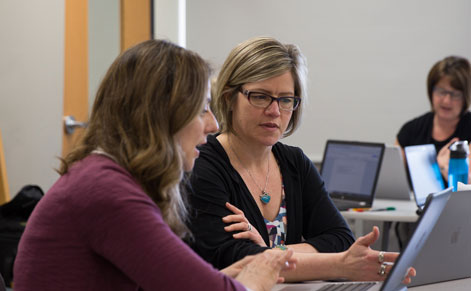Math teachers in middle and high schools across the nation could improve communication in their classroom—and therefore student learning—through new materials developed by Michigan State University researchers.
These tools for transforming discourse, which also have been used in teacher preparation courses, were created and tested in partnership with about 150 secondary teachers over five years. The Mathematics Discourse in Secondary Classrooms (MDISC) research project has been led by MSU teacher education Professor Beth Herbel-Eisenmann with funding from the National Science Foundation. Now the program is available for purchase through the publisher, Math Solutions.

Leah Jones, an eighth grade mathematics teacher at MacDonald Middle School in East Lansing, discusses her practice with Professor Beth Herbel-Eisenmann of Michigan State University.
The materials were studied with teachers in seven different locations in Delaware and Michigan.
“This is the single most important professional development I’ve ever been a part of,” said Laurie Busby, a middle school math teacher for more than 30 years. “This has directly impacted my practice and has directly impacted the success of my students.”
After she started experimenting with strategies with support from Herbel-Eisenmann and her team, Busby moved away from the common model for talking in math class: teacher Initiates, student Responds, teacher Evaluates, or IRE. She began using a set of six Teacher Discourse Moves shown through research to facilitate more productive and powerful interactions for learning:
- Waiting
- Inviting Student Participation
- Revoicing
- Asking Students to Revoice
- Probing a Student’s Thinking
- Creating Opportunities to Engage with Another’s Reasoning
 Herbel-Eisenmann said the MDISC learning materials cover these moves and encourage participants to think about two key areas, or conceptual lenses, to understand what happens when they use those practices:
Herbel-Eisenmann said the MDISC learning materials cover these moves and encourage participants to think about two key areas, or conceptual lenses, to understand what happens when they use those practices:
1) Language Spectrum. How does the communication context (i.e. small group, whole class reporting out, writing a solution, reading a textbook) influence the language used to communicate about mathematics? How do the various representations (i.e., graphs, tables, equations, drawings, story contexts) shape the way students communicate? How might teachers scaffold students’ ways of communicating toward more precise mathematical communication, while also valuing and respecting more informal ways of using language to make meaning?
2) Positioning. How can discourse in the classroom contribute to how students see themselves and each others as learners?
Making mathematics learning equitable is a core principle of the work, she said.
“As mathematics teachers, we rarely have an opportunity to step outside of the more typical interaction patterns like lectures and the IRE pattern to examine these critically and try alternative discourse moves,” Herbel-Eisenmann said. “This is necessary, however, if we want to open up more space for students to participate in mathematics classrooms.
“We have to see ourselves as people who are supporting students to learn to explain and justify their thinking while simultaneously thinking about whether we’re honoring students’ thinking and ways of interacting. If we don’t constantly think about both of these things, it’s hard to create equitable spaces where every student feels valued and sees themselves as capable of making sense of mathematics.”
The package includes a published facilitator’s guide with seven learning modules called Constellations, downloadable participant guides, video and audio clips and presentation slides. The Constellations take about 36 hours to engage with, followed by a recommended action research component in which teachers enact and reflect on changes in their practices over at least two years.
The co-principal investigators and authors are Michelle Cirillo of University of Delaware and Michael D. Steele of University of Wisconsin-Milwaukee. Two additional authors, Kate R. Johnson of Brigham Young University (Ph.D. ’12, Teacher Education) and Samuel Otten of University of Missouri (Ph.D. ’14, Mathematics Education), were lead graduate research assistants when the materials were developed.
Learn more
Otten is the host of the Mathematics Ed Podcast. Hear an episode of the podcast featuring MDISC.
The MDISC research is continuing in partnership with teachers in East Lansing Public Schools. Niral Shah, assistant professor of teacher education at MSU, also is collaborating as he develops an application that helps teachers identify bias in their teaching. Learn more about the EQUIP app.
Learn more about the MDISC professional learning materials via the Math Solutions blog.




